Regional transport body says East West Rail is needed in full to boost economic growth.

 Bagnall
Bagnall
UK Rail is at “a fork in the tracks” facing either renewed growth or “a spiral of decline”.







Regional transport body says East West Rail is needed in full to boost economic growth.

 Bagnall
Bagnall
UK Rail is at “a fork in the tracks” facing either renewed growth or “a spiral of decline”.






Welcome to this conference edition of RIA members’ magazine, The Railway Industry. I look forward to seeing many of you, our fantastic members, over the next two days of the conference to debate the rail issues of the day.
Despite all the political and economic turmoil of 2022, the big railway story this year has been the impressive return to rail.
Within six months of pandemic restrictions starting to be lifted in late February this year, passenger levels on the national network reached 8595%, with revenue figures improving too, hitting 85%, nudging 90%. These figures are baselined against the pre-pandemic year up to March 2020, which were the second highest passenger numbers on record. Freight numbers returned to 100% of pre-Covid levels in September last year.
The biggest impediments to the return to rail have been heatwaves and industrial action. And whilst there have been some changed travel patterns, the bounce-back has been much
stronger than many predicted during Covid. We now need to take a ‘can-do’ approach to attracting back passengers and revenues, and not entertain talk of managed decline.
The reason why it is important to recognise this bounce-back is to signal to the Treasury that rail is a crucial industrial sector, driving jobs and GVA, and generating tax revenues – so it needs to support investment in rail now and in the future, with more capacity being needed. Rail is a growing industry, as reports by both Oxford Economics and Unife, the European rail suppliers’ association, testify. Rail is going in the right direction and growing, not just in the UK, but also in export markets around the world.
So our message to the Treasury and to Government is: don’t cut back, don’t take your foot off the pedal on railway investment when UK rail is bouncing back from the pandemic. Elsewhere in this issue I set out in more detail exactly what we think the Government should do to support our sector.
As with the Annual Conference, this issue of The Railway Industry magazine looks to our industry’s future. We have inspiring updates from two RIA Board members: Kelly Warburton on the progress created in the Global Centre of Rail Excellence, a £250 million test and innovation hub that will be built in South Wales; and James Bain, Worldline CEO and new Chair of the Rail Supply Group, on how the RSG, which brings together Government and the private sector, will focus on cost, reform and supply chain resilience.
We also have an interview with Bill Reeve, the refreshingly open Transport Scotland Director of Rail, who makes a direct appeal to UK suppliers to work
with Scotland’s Railway to deliver cheaper electrification. And Shadow Rail Minister, Tan Dhesi MP, sets out Labour’s plans on rail nationalisation if it wins the next General Election.
Here at RIA, I would like to take this opportunity to thank our members for their support throughout the year, and for also backing our RIA/Women in Rail Equality, Diversity & Inclusion Charter, set up in 2020 to promote an inclusive workforce and a diverse talent pipeline. We are now on the cusp of 200 organisations’ signatories – if you haven’t signed up to the Charter and would like to do so, please let a member of the RIA team know.
Finally, talking of Team RIA I would like to offer every member of the team my profound gratitude for all their hard work in what has been a very challenging year for everyone. I know that they are now organising a strong programme for 2023, and encourage all RIA members to take part in as many of the events and activities as possible. The more you put in to your RIA membership the more you get out!
To all, enjoy conference.
Darren Caplan
Railway Industry Association Chief Executive

Darren Caplan • Chief Executive
Milda Manomaityte • Innovation Director
Robert Cook • Policy Director
David Clarke • Technical Director
Neil Walker • Exports Director
Gaynor Pates • Operations Director
Rose Garber • Member Relations Director
Kings Buildings, 16 Smith Square London SW1P 3HQ United Kingdom
T: +44 (0)207 201 0777
E: RIA@riagb.org.uk
W:www.riagb.org.uk
Michael Burrell Editor
THE
T: +44 (0)20 7089 2622
E: hello@geniumcreative.com
W: www.geniumcreative.com
Railway Industry Association Chief Executive, Darren Caplan, has urged the Government to press on with investment in the railways despite the recent unprecedented political and economic uncertainty.
Speaking on the eve of the association’s annual conference, Caplan said “we are in incredibly difficult economic times, and we do understand that the Government has to take tough decisions. However, rail should be seen as a jobs, investment and tax generator that is good for the UK more widely, in addition to its connectivity and decarbonisation benefits. It shouldn’t be seen as a drain on the public purse to be
cut. It helps the economy grow. Investment now will yield huge dividends in the months and years to come, so we do strongly urge the Chancellor and the Treasury to see rail as a buoyant, productive, helpful sector, not as a cost”.
Setting out a six-point action plan, Caplan said that Ministers should provide certainty on:
■ long-term funding. Taking inflation into account, future
spending on rail should be maintained at least at current levels for operations, maintenance and renewals. There should be more visibility on what schemes are in the Government’s thinking on the rail network enhancement pipeline.
■ the delivery of major projects, such as HS2, Northern Powerhouse Rail, East West Rail, the Midlands Rail Hub
 Darren Caplan, Chief Executive, Railway Industry Association
Darren Caplan, Chief Executive, Railway Industry Association
“Rail should be seen as a jobs, investment and tax generator that is good for the UK more widely, in addition to its connectivity and decarbonisation benefits”.
and Crossrail 2, all of which are schemes that need to be delivered over the next 20 to 30 years. In particular, Ministers need to reaffirm that HS2 to Manchester and East West Rail will both go ahead.
■ Great British Railways. A Transport Bill to legislate for the creation of Great British Railways is now being delayed. Delay in setting up GBR threatens a hiatus in work pipelines because decisions may not be taken in the months ahead that would have been taken with progress on GBR. The Government should push forward as much as possible on strategic plans, regardless of legislation.
■ a rolling programme of electrification and support for hydrogen and battery trains for less intensively used parts of the network. Further progress is needed on these decarbonisation measures, with work being ramped up in coming years. On electrification, the UK remains a long way behind Germany, France and Italy.
■ the delivery of a digitalised railway network. 65% of rail signals in the UK need to be digitalised within the next 15 years, as otherwise they will become obsolete. The capability

will need to be built up gradually, with work starting immediately to make it possible to deliver the 65% target.
■ research, development and innovation. Recognising that there is always a gap between having great ideas and implementing them, the Government should provide support to raise research, development and innovation up the agenda. That would be the best route to an efficient and effective future railway.
Caplan also reminded the Great British Railways Transition Team that RIA has expectations of it, if and when it is taken forward, with five tests that should be met:
These should be:
■ no hiatus in decision-making, so that work can go ahead on infrastructure, signalling, renewals and enhancements;
■ transparency, with decisions being taken not behind closed doors, but with the full input and understanding of everyone in the rail industry;
■ partnership, recognising what RIA and its members can bring to the party, including the role of the private sector on private funding in the future, particularly
in straitened economic times;
■ sustainability of the industry, with GBR being key to smoothing ‘boom and bust’, to ensure visible pipelines and certainty of work projects; and
■ a positive legacy in the areas of safety, decarbonisation, exports and the economy.
Caplan said that RIA will continue to support the GBR Transition Team in its work to bring track and train closer together, to ring-fence day-to-day decision making from Government interference and to move to a regionalised structure.
He hopes that the Transition Team will come up with a mechanism to promote collaborative working. He wants the team to set out the right balance between strategic and day-to-day decision-making –Caplan said, “we are very clear that the Department for Transport has a strategic role in setting out the direction of rail in the UK, but dayto-day decisions should be taken by rail experts who work in the railway industry, who know best what needs to happen in terms of operations and investment”. He said that RIA agrees with the objectives of regionalisation, of having decisions taken as close to people as possible, believing that is better for those who work in rail, for the communities it serves, and for rail users as well. ■

 Mark Thurston Chief Executive Officer HS2
Bill Reeve
Mark Thurston Chief Executive Officer HS2
Bill Reeve
He told The Railway Industry Magazine that it is the Scottish Government’s “firm intention” to continue to deliver a rolling programme of electrification that will provide “a stream of work for the supply chain”, though he warned that what he called the “fiscal turmoil” within the UK Government was “our biggest
obstacle to reinforcing that certainty of our programme”. At the simplest level, he said, “it is a bit hard when you don’t know what your budget is going to be in two years or even perhaps next year. That is absolutely the result of the fiscal uncertainty that the Scottish Government’s overall financial settlement from the UK Government is subject to”.
Similarly, asked what the Scottish Government expects from the new Ministerial team at the Department for Transport, he said “the honest answer is we don’t know yet”. He noted that the previous Secretary of State had indicated that rail legislation faces deferral, which he described as “not perhaps the most surprising news we have ever
received, but it was news, and it was different from what we were being told a few months’ before”. Reeve said he continues to see “a widespread acknowledgement that the current rail industry structure and legislation are sub-optimal”, adding “Team Scotland works in partnership to deliver progress despite the deep flaws of the current rail industry structure”.
In a wide-ranging interview he was keen to focus on how, despite these flaws in the structure, the Scottish Government works in a close partnership with Network Rail in Scotland and publicly owned ScotRail as Team Scotland, with a shared objective of delivering a highquality railway in a market that it expects to continue to grow, both for passengers and freight.
Reeve said that commuting and business travel patterns in Scotland have changed, observing that “we don’t see the morning and evening peaks that we used to”. Saturday is now the busiest day on the network for passenger demand and longer distance leisure travel is growing. Transport Scotland is also seeing “the beginning of what we discern as a substantial shift towards rail from road freight”.
Asked about the transfer into public ownership and control of ScotRail services in April this year, he said that there had already been progress towards more joined-up working than when the rail operator was in the private sector. Its transfer into the public sector had made that even easier. Earlier concerns about sharing commercially sensitive information are no longer the same. As a result, he said, recommendations to the Scottish Government about additional funding for electrification, for example, are based on an analysis of the whole railway business, passenger and freight, considering
not just higher infrastructure costs, but also much lower operational costs and service improvements. He also emphasised that the Scottish Government’s Rail Decarbonisation Action Plan was “a real guiding light” in all our plans for developing the railway.
In Scotland, he joked, we spell “decarbonise” “e.l.e.c.t.r.i.f.y”. The reason, certainly on the railways, was that electric trains are cheaper to buy, cheaper to operate, perform better and free up capacity – and Reeve suggested that people tend to under-estimate the capacity benefits that the improved performance of electric trains creates, particularly on a mixed traffic railway.
He said that a steady stream of electrification work is important
because a rolling programme provides a learning curve that drives efficiencies and continuous improvements. He hoped that RIA members would see “that we do what we say” on electrification. “So, on the ground now in Scotland the electrification to Barrhead is contracted and under way. That includes the first bit of the East Kilbride line; the contract for the last bit of that line will follow shortly. We are on the ground already electrifying from Haymarket to the southern end of the Forth Bridge. There are electrification piles in the ground on the Levenmouth branch”.
In his meetings with suppliers, alongside Transport Scotland’s delivery partners, Reeve said he sees “a strong willingness to be part of Team Scotland. I think there is an appreciation that what we do here
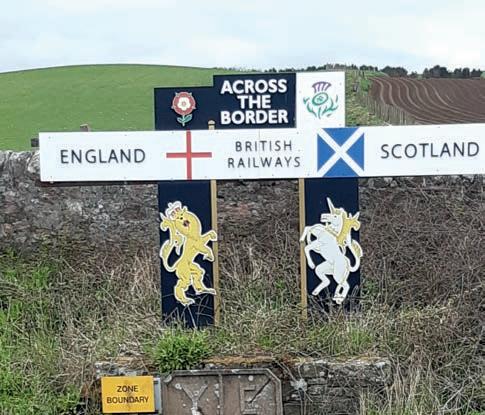
“Team Scotland works in partnership to deliver progress despite the deep flaws of the current rail industry structure”.
is different from some other places and I hope there is more confidence in the likely deliverability of our plans than there perhaps may be in some other places. I would say to all RIA members who don’t work in Scotland, you might want to look at whether that is a market you would like to get into, because the grass really can be greener on the other side of the border”. Reeve also emphasised that Team Scotland is keen, wherever it could, to buy in a way that stimulates the health of the supply chain in Scotland and employment.
He noted that Network Rail in Scotland is looking at how electrification programmes have been delivered in some countries at lower cost than in the UK and spoke of “a shared commitment first to get electrification down under £2m per single track kilometre and to push it down very much further than that. Do I think that is possible? Yes, I absolutely do. The level of overheads to direct costs in Network Rail electrification costs remains unacceptably high – things like the scale of preliminary costs, the scale of design costs, the level of project management fees. It is all too topheavy at the moment”
Reeve was keen to “sing the praises of my colleagues in the Network Rail Scotland team who are with us in that team effort driving down costs. They understand the strategic imperative of improving efficiency in the delivery of our electrification. These are really constructive partnership discussions here in Scotland and we have made progress and we are already delivering more cheaply than I understand to be the case south of the border”.
He said that lessons had been learned in Scotland from “the abomination and disaster which was the Great Western electrification”, describing it as an opportunity that Network Rail and its suppliers
had completely wasted. The “embarrassing costs and delays” in the Great Western programme had made electrification “a toxic prospect” for UK Ministers and he added “The people who did the design included RIA members. The people involved in that strategic disaster included RIA members. There is a collective failure in that disaster. It was very, very badly done”.
Looking further ahead and concluding on a positive note, he had praise for companies in the supply chain who have been working with the Scottish Government and its delivery partners on innovative projects for both battery electric trains and hydrogen fuel cell trains.
Describing battery electric as a technology that has matured, he said that Scotland is currently in the early stages of procurement for a fleet of battery electric trains. That is because Scotland cannot roll out electrification quickly enough to replace the first tranche of diesels that will need to be replaced. Battery electric technology, he said, was “a proven technology to help us
with that and it allows us to focus our electrification efforts on the mixed traffic trunk routes, while for routes that only have passenger services over short distances, we can use batteries at least as an interim solution”.
Hydrogen fuel cell technology, by contrast, was not yet a mature technology for trains, but the Scottish Government is investing in rail trials as part of a wider programme to stimulate the hydrogen economy in Scotland. A consortium supported by the Scottish Government involves The University of St Andrews with private partners including Angel Trains, a Scottish division of Ballard Power Systems and Brodie Engineering. Together they have converted an old ScotRail electric unit to fuel cell traction. He described that as “a useful learning experience because we want to build that expertise within the Scottish economy”. Reeve said he had no doubt that technologies like hydrogen would eventually have a role to play in some parts of the network, particularly on longer, less-densely used routes like the Far North Line in the Scottish Highlands. ■
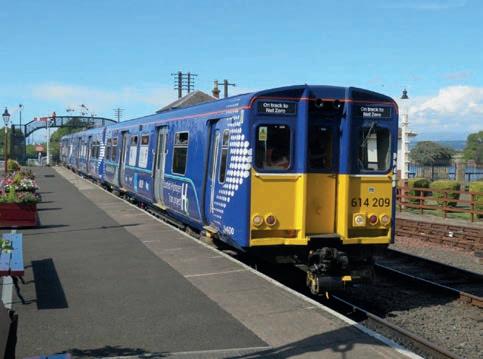
The Chief Executive of Rail Partners, the new trade association for the train operating companies, has condemned Labour’s plans for rail nationalisation as “the wrong answer” but also urged the new Conservative Government to end uncertainty about the future of the rail industry.
Andy Bagnall told The Railway Industry Magazine that the nationalisation plans announced by Labour at its party conference would not help the industry to grow. He challenged Labour to explain “how simply the change of ownership can make the trains more on time or fares be cheaper?”. For us, he said “it is actually about harnessing the best of the public and private sectors in a reformed system to focus outwards
on the customer”.
Addressing the current Conservative Government, he said it was understandable that a new administration would want to take a moment to consider the direction of travel for the rail industry, but he urged Ministers to move quickly and appropriately to “make progress to restoring the sector to growth”. He warned that “getting the wrong reform under the White Paper
structure – if the role of the operator is too constrained by the Great British Railways model – would lose the benefit of private sector input, innovation and customer focus”.
Bagnall said “there is a moment in time here. There is a fork in the tracks. If we make the right choices now, we can return the railways to being the thriving sector it was before the pandemic. If we make the wrong choices, there is risk here.
 Andy Bagnall, Chief Executive, Rail Partners
Andy Bagnall, Chief Executive, Rail Partners
If we have a prolonged hiatus and further uncertainty or make the wrong choices about the future model of the railway, I believe that could lead to a spiral of decline”.

He warned that “if we don’t attract people back to the railway, if we don’t respond to those changing patterns of demand that we are seeing post-pandemic, we risk a focus being on cost reduction and that leading to service cuts and that in turn leading to a less attractive railway and fewer passengers and freight customers using it. We have got to get into a virtuous circle where we are attracting people back, revenue is returning and that allows us to remake the investment case to politicians in terms of the public contribution to the railway”.
Asked what Rail Partners, which was spun out of the Rail Delivery Group five months ago as the policy and advocacy arm of the train operators, would consider to be the right way forward, Bagnall said “the headline for us is that Great British Railways should be a guiding mind, but not a controlling mind”.
Focussing on GBR’s relationship with the train operators, he said “we must have a culture of an intelligent client, setting outcomes, but not being too prescriptive, too specifying in terms of the contracts it wants operators to deliver. Giving that freedom within
the contracts will allow operators and the system as a whole to look outwards to the customer, focus on how their behaviours are changing post-pandemic and respond to that with a view to attracting more customers and ultimately returning the railways to growth”.
Bagnall said that key to success would be getting the design right for passenger service contracts. “For us”
he said “it is about having the right incentives in the contracts, where operators are incentivised to regrow the railway, to attract people back to using rail as their preferred form of travel. It is important to stress that the contracts should not be ‘one size fits all’; that means different forms of incentive in the different markets that the railway serves, so a difference between urban commuter markets and long distance”.
He also stressed that “having incentives will only be successful in driving those right behaviours if operators have the right levers to be able to respond to those incentives. That means having the right inputs into things like timetabling and fares, that deliver against an overall framework set by Great British Railways. Operators can then look outward to customers and respond to their changing needs as opposed to decisions being prescribed from the centre. If we also get a healthy balance of risk and reward that will lead to a vibrant market”.
Asked about his view of the rail supply industry, Bagnall said that “a very innovative supply chain supports the railway. It is absolutely critical to the delivery of train operations that our members undertake, both passenger and freight, and, of course, also on the infrastructure side. I think the supply chain needs very similar things to the railway as a whole, which is a degree of clarity and certainty about future direction and stable pipelines so that it can plan and invest against them”.
On Rail Partners’ relationship with RIA, he said “we work very closely. We represent different constituent interests, but both parts are absolutely essential to the effective running and operations of the railway. We have a lot of similarities of interest – the need for clarity around the future direction of travel and reducing uncertainty. Wherever it is appropriate we work together. At the party conferences we ran a series of events – RIA, Rail Partners and the High-Speed Rail Group –to foster and encourage debate and to put across some of those messages about the really valuable contribution that the private sector makes to the railway, both in terms of the supply chain and day-to-day passenger and freight operations”.
“Having incentives will only be successful in driving those right behaviours if operators have the right levers to be able to respond to those incentives”.Kelly Warburton
A unique rail innovation centre in South Wales, whose creation has been funded by both the Welsh and UK governments, is set to launch an investment prospectus to attract private funding “very shortly”.
Kelly Warburton, the centre’s Chief Commercial Officer, told The Railway Industry Magazine that the centre is making good progress on the prospectus which will set out why the Global Centre is “a strong proposition
for private investment”, but she emphasised that, while bringing private funding on board is critical, “what we are also looking for are partners that can work with us in collaboration to help us drive the innovation and new ideas we
need – a genuine partnership that represents not only a good investment, but also allows us to share a wider skills base and share capabilities and capacities to help us tackle some of the big challenges in rail today”.
Attending the InnoTrans fair in Berlin in September, she said “we had people queuing up to talk to us about the site, our plans and how they can collaborate with us”. She described the GCRE project as “one of the most interesting and innovative ideas in all of rail today”, which would fill an important gap that had existed in rail for a long time by creating a world-class integrated facility for the testing of rolling stock and infrastructure. It would provide a ‘one stop shop facility’ for cutting edge innovation and collaboration, with storage, calibration, validation and training all happening on the same site.

Warburton said it was time for the industry to “stop using major capital projects or the operating railway as a test bed for new products, if we are to deliver reliable cost-effective services to the travelling public and freight customers. GCRE can be a major step towards achieving this. It would be “a space that brings people and ideas together from across rail, from across the private and public sectors and from across academia so that we can, collectively, find the answers we need to the challenges we face as an industry”.
Describing cost control as “one of the major challenges in rail today”, she said “we have seen in recent times with projects such as HS2 and Crossrail, projects that are fundamentally good ideas that enhance our transport infrastructure, the challenges that come when costs overrun. We simply have to find a way to make the construction of our critical infrastructure more affordable and one way we can do that is by testing new ideas, new technology and new processes before they are deployed live”. She said it was “much better and much more cost efficient to think through problems at a site like GCRE, rather than on site, on the mainline and in
the middle of a major project”.
Another pressing public policy challenge for the centre would be to address “how we all support the path to Net Zero”. Warburton said it was clear that one way to do that is to develop an integrated, low carbon, multi modal and affordable transport system right across the UK”. Getting there would require innovation, new ideas and the testing of new technologies and, with partners in the industry and in higher education,
GCRE would be “an exciting place to do just that”.
The centre is being developed on the 700-hectare site of a former open cast mine at the head of the Dulais Valley. Adjacent to the Brecon Beacons National Park and 15 minutes from Neath, the site is “ideal in its shape and topography”, Warburton said. Offering benefits for the rail industry, its customers and the national economy, she said it would also help in the creation
“The GCRE project is one of the most interesting and innovative ideas in all of rail today, which would fill an important gap that had existed in rail for a long time by creating a worldclass integrated facility for the testing of rolling stock and infrastructure”.Kelly Warburton,
Chief Commercial Officer, GCRE
of high-quality jobs and skills and “build a bright industrial future for a community impacted by deindustrialisation”.
With planning permission secured and a team in place, GCRE will have “spades in the ground” from the beginning of next year. Phase 1 of the project will see the construction next year of sidings for rolling stock. From 2024 Phase 2 will see the building of two electrified test loops, one high speed test loop, 6.9 km long and a 4km infrastructure test loop, together with supporting infrastructure and buildings. From 2025 Phase 3 will see the addition of expanded stabling, maintenance and commissioning facilities, along with research facilities, a hotel and a business park.
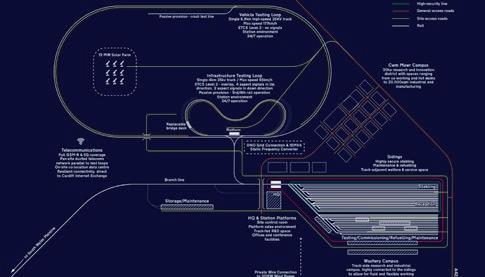
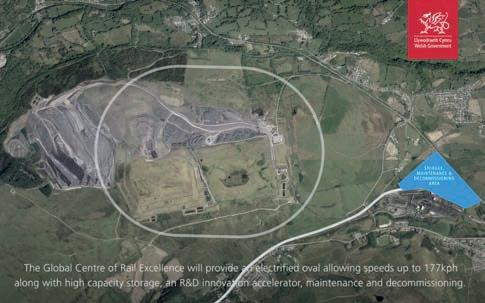
Warburton joined GCRE in June this year after nearly 18 years at Unipart Rail, latterly as Managing Director UK and Europe. She said that, as Unipart operates across both the traction and rolling stock and infrastructure sides of the industry, it had given her an understanding of the market as a whole and an experience of the supply chain which she believed would be key assets for GCRE. Warburton also continues to be a member of the RIA Board, which, she said, would “provide access to the entire supply chain to help me understand what it needs from GCRE”.
Her enthusiasm for and commitment to the project shines through in everything that she says. As she puts it, “It is brilliant to be involved in something new. It is a critically important project for the industry and to be involved in a project where cooperation between the public and private sector is critical to its success is unique. To have involvement in something which will bring real social value to the locality in which it is being built
is great. What an opportunity, and one I couldn’t afford to miss”.
As a mother with a young daughter, Warburton was also keen to emphasise, as a final thought, that she and the GCRE team are passionate about “making the most of the opportunity we have, as a new organisation and a new entrant to the rail scene, to play a very active leadership role in making rail a place that looks and feels like the world around it. We are all fundamentally committed to building GCRE in a way that ensures values of fairness, equality and diversity and issues such as gender diversity and work life balance are are at its heart from the very start”. ■
GCRE team are passionate about “making the most of the opportunity we have, as a new organisation and a new entrant to the rail scene, to play a very active leadership role in making rail a place that looks and feels like the world around it”.Philip Sherratt
The Editor of Modern Railways, Philip Sherratt, says that the new Conservative Government needs to give the rail industry “certainty and have a clear plan that will be stuck to”.
He told The Railway Industry Magazine that Ministers need to set out their plans for Great British Railways and outline their investment priorities for the industry.
Sherratt said he was encouraged that both the then Transport Secretary, Anne-Marie Trevelyan, and the then Rail Minister, Kevin Foster, had taken the opportunity of
the Conservative Party Conference in Birmingham to visit the HS2 Curzon Street site. He hoped that the Rail Minister would follow up with further visits to key HS2 sites to see for himself the benefits of investing in rail. He also said that the Government should offer a further long-term funding plan for Transport for London to enable it to buy new trains for the underground
network. Sherratt said he appreciated that the Government faces multiple challenges and has all sorts of other priorities, but it should understand the key contributions that rail can make to both economic growth and decarbonisation. Crucially, it needed to end the current “state of limbo” and set out a road map for how and when it intends to deliver
on the establishment of Great British Railways.

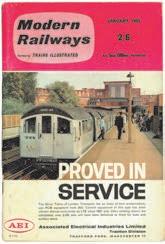
He suggested that the Government at Westminster should take a close look at what is already being achieved in Scotland – both in terms of the alignment there between the rail operator and Network Rail and the clear and ambitious plan for decarbonisation that the Scottish Government has announced.
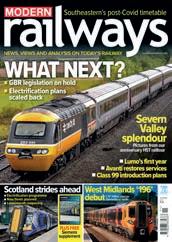
Sherratt said that the UK rail industry is facing huge challenges finding ways to close the gap between passenger numbers and revenues. As one operator had put it to him, currently “we have got 80% of the revenue back, but we are still operating with 100% of pre-Covid costs”. He said that, while the rebound in leisure traffic was impressive and welcome, it seemed clear that some degree of hybrid working would continue, leaving a big gap due to the fall in season ticket and business travel revenue. He urged the Government to grasp the nettle of fares reform and said what was needed was a vision that would enable train operators to go out and market themselves, to get the revenue and for them to be incentivised to do that.
Reflecting on the UK rail supply industry, Sherratt described it as a “hugely significant sector” in terms of its scale, the number of people involved and the wealth that it generates. It was also notable for the contribution that both large and smaller companies make to technological development and innovation. He said that the Railway Industry Association plays a key role in providing a forum for industry networking and in representing the industry to Government and suggested that its status and influence has grown considerably over the last five years.
Turning to Modern Railways, which has been celebrating its 60th anniversary this year, Sherratt said that it too had evolved from its origins as Trains Illustrated in the 1940’s, when it was much more a magazine for rail enthusiasts. In 1962 the magazine’s name was changed to Modern Railways to reflect the changing content, which was now also focussed on reporting on changes in the industry from a business-tobusiness perspective.
Sherratt said the editor at the time, Geoffrey Freeman Allen, was developing a magazine that was “written from the inside. We were talking to the key players and reporting on developments from the inside, rather than being like a trainspotter on the platform looking at things from the outside, and that is very much where we still are today. The magazine’s position at the heart of the industry has remained the same”.
A lifelong railway enthusiast, Sherratt
“UK rail industry is facing huge challenges finding ways to close the gap between passenger numbers and revenues”.Quartet of Editors - Geoffrey Freeman Allen (founding Editor), Charles Long, James Abbott, Ken Cordner. Photo by Roger Ford
began reading Modern Railways in his early teens, joining the editorial team in 2014. He became Editor in March 2020, five days before the country went into the first coronavirus lockdown. From then on, he said, “we were all making it up as we went along and all getting to grips with doing things online, but we carried on printing the magazine and, like the railways, we never stopped”.
Reflecting on Modern Railways today, he said that the magazine “always looks at things with a critical eye and has always been outspoken when it wants to be. We would like to see ourselves as a critical friend. All the people who write for the magazine are people who love railways. If we are criticising, it is because we think things could be better and we think there are ways things could be improved”.
Sherratt said that “one of the skills of our writers, from a technical point of view - people like Roger Ford and Ian Walmsley - is their ability to take complex concepts around things like engineering and explain them in a way people can understand. I think that is important and a really valuable asset to the magazine and indeed to the rail industry”.
A key moment in the magazine’s development commercially was the change from a monolithic state-
owned British Rail to privatisation which opened new opportunities for the magazine and led to the establishment of awards events, such as the Railway Innovation Awards, organised in conjunction with the Railway Industry Association. The magazine also has an online presence, including a licensed online directory product called Modern Railways Insight.

This year Modern Railways has been celebrating six decades of charting key developments in the industry and looking to the future of the railways. Its diamond jubilee celebrations will culminate on 22/23 November with a brand-new expo in Milton Keynes showcasing the
future of Britain’s railway. As well as exhibitions and networking opportunities, conference sessions across the two days will include a session on train service delivery, a focus on issues around rebuilding revenues and a keynote address from Anit Chandarana, Lead Director at the Great British Railways Transition Team.
Explaining the new show’s importance and the thinking behind it, Sherratt said “we cover the whole of the railways and we have a broad overview of the industry, so we should have a show that reflects that. It is about bringing people together. It is a new concept, and we think it is exciting. It has got huge potential to really fit well and be a successful
“The magazine always looks at things with a critical eye and has always been outspoken when it wants to be. We would like to see ourselves as a critical friend”.
“We cover the whole of the railways and we have a broad overview of the industry, so we should have a show that reflects that. It is about bringing people together. It is a new concept, and we think it is exciting”.Philip Sherratt, editor of Modern Railways
part of our portfolio alongside our existing print and online content, awards events and regional conferences. It is very important to us”. ■



To find out more about Modern Railways EXPO visit www.modernrailways. com/expo, where you can register for free to attend the event.


The Rail Supply Group, led by its new Chair, James Bain, is to adopt a new focus on delivery in three key areas: cost, reform and supply chain resilience.
The Group, which uniquely brings together Government and the private sector to deal with supply chain issues, has taken a decision to abandon earlier plans to look at delivering the WilliamsShapps plan, increasing customer revenues and sustainability and decarbonisation. Instead of looking at long-term strategy and whole industry strategic plans, the Group will seek to deliver concrete initiatives in the short (12 months) to medium term (36 months). Specific proposals will be put to a meeting of the Group’s Council on 15 December. Bain, who took over as the Group’s
Chair, in July previously worked at Virgin Trains and is now CEO UK and Ireland at global payments company, Wordline, an established supplier of payment systems to every part of the UK rail industry. Noting at the time of his appointment that the bicentennial of the historic Locomotion service from Stockton to Darlington is almost upon us, he said that “private sector innovation partnered with public sector delivery will ensure that the railway will be fit for the next two hundred years”. In the weeks since then Labour has confirmed at its party conference that it will nationalise the rail industry, while doubts have
emerged about whether the new Conservative Government will go ahead with legislation to implement the Williams-Shapps plan and establish Great British Railways.
Despite this, Bain told The Railway Industry Magazine he remains convinced that “change has to happen” and that the Group is uniquely well-placed to pull together private sector and Government views. He said that the Group aims to “bring value from the supply chain to improve the economic position of rail and to provide support for the ambition and

“Rail Supply Group aims to provide support for the ambition and strategy that Government and industry want to follow for the growth of rail and how that can accelerate growth for the whole UK”.
strategy that Government and industry want to follow for the growth of rail and how that can accelerate growth for the whole UK”. Also, Bain said, “we are focussing now on what it means for the people who use trains to travel and the freight companies that use the rails to move goods around”.

Commenting on the Group’s three new areas of focus, he said that on cost, “there is an issue with cost in the industry. The £20bn per annum that it costs the taxpayer is going up. Together with the revenue position, which is around 20% less than preCovid, the industry is facing a £4bn financial challenge in the coming year”. Emphasising that the Group has yet to decide what specific initiatives it will take on cost, he suggested that a key area could be the “strait-jacketed and increasingly prescriptive procurement contracts” that precludes the supply chain from proposing innovation that could lower price and, therefore, cost. He said he believed that “with more flexible procurement the supply chain would be able to create compelling commercial offers, lowering cost and driving customer benefits”.
On reform, Bain acknowledged that this is a wide-ranging subject, but said that what the Group is looking to do would be to bring the broad experience of the supply chain that sits round the table from other markets that had reformed and transformed themselves – such as telecoms, manufacturing, retail and hospitality, both in the UK and abroad. The objective would be to share the lessons, the pitfalls and the successes with industry and with Government as they plan the future reform and the future operating model of the industry. In addition, the Group would be asking for the supply chain to have a proper seat at the table in the future governance of the industry.
On supply chain resilience, Bain said that while the immediate thought when the subject was mentioned was usually about the financial viability of SMEs if the industry stalled or stagnated, there was another issue that was less often discussed. This was about suppliers’ willingness to continue working in a rail industry where efforts to introduce innovation are regularly frustrated, leading some businesses to think about whether they might be better off investing in a different sector. Bain said that this is an issue that the Department for Business, Energy & Industrial Strategy and the Department for Transport has asked
the Group to consider.
Asked for a broader comment on the input to the Group from those two Government Departments, Bain said “They play an equitable role across the table. They are fundamental stakeholders. My experience with both DfT and BEIS is that they have been tremendously supportive of the Rail Supply Group. They have provided people, resources and guidance. They have not been overbearing, dictatorial or prescriptive. It is a very open, collaborative conversation and that might surprise some people”. ■
“We are focussing now on what it means for the people who use trains to travel and the freight companies that use the rails to move goods around”.James Bain, Chair of Rail Suppy Group


 Tan Dhesi MP, Shadow Rail Minister
Tan Dhesi MP
Tan Dhesi MP, Shadow Rail Minister
Tan Dhesi MP
Shadow Rail Minister, Tan Dhesi, has told The Railway Industry Magazine that an incoming Labour Government would take “a very measured approach” to rail nationalisation.
He confirmed that the focus would be on taking control of the train operators. State ownership of rolling stock companies “is not our priority at the present time within the nationalisation process” he said.
Dhesi said Labour sees that “the orderly transition to a publicly owned railways will be in the best interests of the taxpayer, as well as the passenger and the wider rail industry. We will see where we are when we take charge, but our approach is definitely a very measured approach which
we feel will bring best value for money for the taxpayer as well as passengers”. He said that Labour envisaged “a central guiding mind to ensure that we set the timetables; we take charge of the operators so that we can have an affordable, accessible and convenient train system”.
The Shadow Rail Minister also said that a Labour Government would invest in rail with an annual rolling programme of electrification to decarbonise the transport system and the economy more widely. He declared “we believe in rail in terms
of a long-term vision, and we fully support the delivery of the major rail projects”. Labour’s priorities for delivery would be HS2 in full, including the Golborne Link or an effective replacement, and Northern Powerhouse Rail in full. He said that a Labour Government would also support the Midlands Rail Hub, East West Rail and a western rail link to Heathrow Airport. In addition Labour would invest in the upskilling of the workforce to fill the skills gap identified by The National Skills Academy Rail.
On the rail strikes, he said Labour had kept on asking the Government when they were going to negotiate. We asked, he said “why are you not getting round the table and ensuring that our rail workers – who the Transport Secretary himself lauded as key workers during the pandemic – get a decent wage and decent terms and conditions? They need to be listened to and we need to make sure that we get a good compromise solution for all concerned. They didn’t do that and that is all part, I fear, of the Government not really understanding rail and in fact betraying the public on that”.
Reflecting on the recent Government reshuffle, Dhesi said it was “too early to say” what impact a new Secretary of State for Transport and a new Rail Minister would have, but he was highly critical of what he described as “this constant chopping and changing of Ministers”. He said it was “really bad for an industry like rail which deserves long-term vision and long-term ambition rather than this short-term approach, because each Minister that comes along has their own way of looking at things”. He gave as an example the
renewed uncertainty about the implementation of the WilliamsShapps plan and the establishment of Great British Railways. He said that the decision by former Transport Secretary, Grant Shapps, to add his name to the Williams Review had “doomed it to failure because as soon as he would no longer be in post then that particular plan would no longer be the top priority of an incoming new Transport Secretary”. Dhesi said that if that plan and Great British Railways were no longer part of the Transport Bill then “I fear that will lead to an even greater hiatus with regard to work within the rail industry”.
Commenting on the industry, Dhesi said that, thanks to RIA’s rail fellowship programme he had recently been to the Siemens facility in Chippenham, and he had also made visits to rail firms in Derby,
Doncaster, Milton Keynes, Swindon and Bristol to see “some of the amazing innovation that is there thanks to our excellent rail firms”. He said he was “constantly being impressed” by rail firms, both big companies like Alstom, Hitachi and Siemens, and small businesses, which he described as “the rock bed of our industry and the wider economy”. He noted, however, that small firms are going through some very difficult times and that they had “again and again been saying to me that we need certainty with regards to how the industry is progressing”. Dhesi complimented the Railway Industry Association on “doing a great job to represent their members” but emphasised his view that RIA members are “being hamstrung by a lack of direction from the Government”. ■
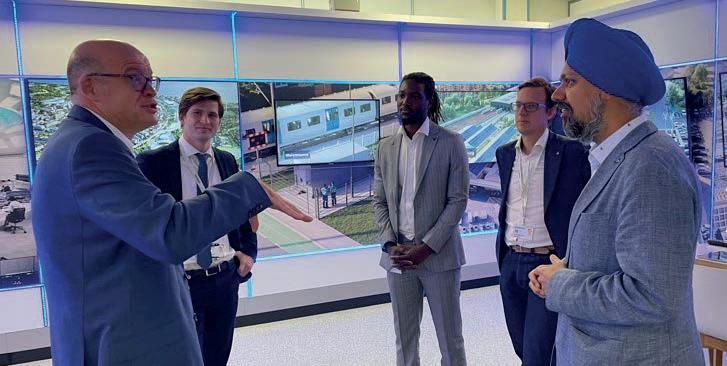
“The orderly transition to a publicly owned railways will be in the best interests of the taxpayer, as well as the passenger and the wider rail industry”.
VOLTAP is the new building block of an electric charging revolution, supporting hybrid and battery trains.
The VOLTAP product line is designed for cross manufacturer compatibility. Enabling mainline electrification, providing branchline range extension. Already tested and in service. Charging through new and existing pantographs.
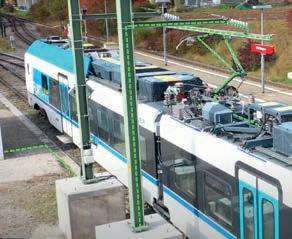
VOLPTAP is designed for trains to run up to 120km+ between charges and to be charged in less than 8 minutes through cutting-edge fast-charging stations.
Charging with up to 2.4MW chargers at 25KV. CONTACT

England’s Economic Heartland (EEH) – one of the seven sub-national transport bodies in England – has provided new evidence to the Government on how delivering East West Rail in its entirety would provide strong support to economic growth.
EEH is the transport body that has the Oxford to Cambridge arc at its heart, but also covers a wider area stretching from Swindon to Cambridgeshire and Northamptonshire to Hertfordshire.
On the day that Liz Truss became Prime Minister, EEH delivered a new report to Government on the economic benefits that the full scheme would deliver and on the breadth of support that East West Rail has from businesses across all sectors in the region.
The Railway Industry Magazine asked EEH Managing Director, Naomi Green, if she is optimistic
about securing Government backing. In reply, she said “to be honest with you, given the economic contribution that the region makes, my advice to the Government would be that they don’t have a choice. This is a scheme that plays a huge role in unlocking economic growth and I think that is well understood by the Treasury and the Department for Transport”.
A REALLY CRITICAL POINT
Green acknowledged that East West Rail is “at a really critical point” and said that EEH is working very closely with the company, local authorities,
local businesses and local MPs to press for the delivery of the entirety of the route from Oxford to Cambridge, including the Aylesbury link. She described East West Rail as a whole as “the enabler of what we call a full coast-to-coast railway that connects down to the southern coast and across to the eastern coast through improvements that we would like to see longer term”.
Green said “supporting a sustainable link to Aylesbury is a no-brainer, but the Aylesbury opportunity is more than just a link to Aylesbury. By connecting it in effect through East West Rail up to Milton Keynes you
can go up to Northampton. South of Aylesbury there is the opportunity to connect all the way down to Old Oak Common. That would create a genuinely new north south line from Northampton that will be really important for passenger and freight movements in that corridor. It is a much more strategic issue than just connecting Aylesbury to East West Rail”.
East West Rail apart, Green said that the other urgent rail priority for EEH is Ely Junction on the Felixstowe to Nuneaton line. She said that improvements to the railway junction bottlenecks to deliver increased capacity for rail freight are “absolutely critical”. They would unlock the rail freight connection between the East of England’s international gateway ports and the Midlands, the North and the rest of the country. EEH has been told that it will have to wait to see if this scheme will be included in the next round of the rail network enhancements pipeline.
Beyond those two priorities, EEH also has other key rail projects that it wants to see supported and delivered, including:
■ a new east west route in the north of the region that would connect Kettering and Corby to Peterborough.
■ Midlands Main Line improvements, including electrification and restoring the level of frequency of trains to Leicester, Sheffield and Derby.
■ enhanced rail capacity and connectivity in Oxfordshire, including between Oxford and Didcot to the southern ports and
■ making the most of released capacity from HS2, particularly around the Northamptonshire area.
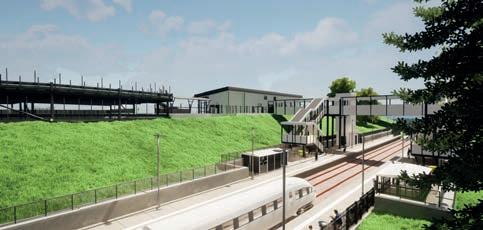
More generally, Green has two other

themes on which she hopes that the rail industry will focus – skills in the transport sector and integration of different travel modes.
On skills, she said “As a sector we need to be much better at bringing people in, because there are huge skills gaps. We need to broaden the number of people that might want to come into transport and make sure that people are energised to come into what is a really fantastic sector. There isn’t enough diversity. We are not representative of the people that we serve. There is a responsibility on everyone who works in transport to encourage people to see this as a career”. She said that the sub-national transport bodies are looking at how they could support bringing more people in through apprenticeships and better
On integration of rail and bus services, she said “My challenge to the railway industry is that people don’t start their journeys at railway stations and actually by working on better integration all we are doing is growing the market. The more people can get to the station easily the more people use it. So therefore it is about working together to grow a market and create more demand so that we can have better services”. Green accepted that this is difficult to achieve because of the fragmented nature of the transport system, but said that sub-national transport bodies, which work across all modes, are well placed to encourage integration. “We have to have the right relationships in the Department for Transport” she said, “and the right level of influence and power to make the changes that we identify, and I don’t think we are there yet on that”. ■
“We need to broaden the number of people that might want to come into transport and make sure that people are energised to come into what is a really fantastic sector. There isn’t enough diversity”.Naomi Green, EEH Managing Director Work carried out on Bletchley high level platform
New Prime Minister, Rishi Sunak, has appointed Mark Harper as Secretary of State for Transport.


The Government and Transport for London (TfL) have announced a longer-term funding settlement until March 2024. RIA met with TfL Commissioner, Andy Byford, in September and Chief Executive, Darren Caplan, commented that whilst the new settlement is a step in the right direction, longer multiannual deals are still necessary to get the best possible value.

Speaking at the Labour Party Conference, Shadow Transport Secretary, Louise Haigh, said that Labour in power would bring our railways back into public ownership as contracts expire.
As Rishi Sunak arrived at 10 Downing Street, RIA set out the key priorities for the future of rail. These include certainty of the work pipeline, delivery of major rail projects, Great British Railways, digitalisation, decarbonisation, and R&D and innovation.
Earlier this year the Department for Transport launched a public vote to find the headquarters of the planned Great British Railways. The shortlist included: Newcastle, Doncaster, York, Birmingham, Crewe and Derby. The vote closed on 15 August and the result, which will be announced by Ministers, was still awaited at the time of writing.
21 October marked three years since the Department for Transport’s Rail Network Enhancements Pipeline, showing the status of rail enhancement schemes at different stages of development, was last published. This is despite the Government promising to update it annually.
Government says, the RNEP will be published “in due course”
Kevin Foster, the then Rail Minister, gave an update on the RNEP. Answering a question in parliament, the Minister said that it will be published “in due course” but that the priority is to provide as much clarity and certainty as possible, rather than publishing a misleading version.
Former Prime Minister, Liz Truss, said she supported building Northern Powerhouse Rail in full, nine months after the Government scaled back plans for a high-speed line across the North of England.
It has been confirmed that Andy Byford, Commissioner of Transport for London, will step down from his role later in 2022. Andy Lord, currently TfL COO, will take over the role on an interim basis.
120 companies from across the UK supply sector joined others from across the globe for the international trade fair, InnoTrans. Senior Department for Transport official, Dan Moore, visited a host of UK companies at their stalls and spoke at RIA’s reception at the British Embassy.

The 2022 Annual Report sets out examples of good practice and celebrates the very best work carried out by Charter signatories over the past year. Submissions to the Report came from over 20 organisations, including the Department for Transport, British Transport Police, Network Rail, ScotRail, Transport for London, Atkins, Costain, Keltbray and Nichols.
Over the summer, the House of Commons Transport Committee published a report on the Integrated Rail Plan, urging Government to reconsider its decisions to scale back Northern Powerhouse Rail and HS2.

Figures published by the Department for Transport show that passenger numbers are now closing in on pre-pandemic levels, with numbers hitting 95% of preCovid levels on 10 August.

From 1 January 2023, the UK will no longer recognise EU certification for rail interoperability constituents, subsystems and entities in charge of maintenance for domestic freight wagons.


Rail Partners formally launched in July and published its prospectus for how it believes its members can support the successful delivery of reform through a reinvigorated partnership between the public and private sectors.
Figures from the Department for Transport show that on 22 September, 3.26m journeys were made, which is the highest number since the start of the pandemic. On that same day, around 276,000 journeys were completed on the central section of the Elizabeth Line, which is the highest daily number to date.
A new UK-Ukraine transport partnership has been announced. It includes commitments to share engineering expertise and a £10m Ukrainian Railways support package.

Former Transport Secretary, Grant Shapps, signed a partnership with Israel in September. It aims to extend the benefits of Crossrail expertise overseas and enable British engineers to team up with companies abroad.
Number of journeys on the London underground hit highest level in two years
AssessTech is a technology and training company specialising in all aspects of Competence Management for the Railway Industry. AssessTech believe in Developmental Competence Management, which is a continuous process that achieves lower business risk and a reduction in incident rates through targeted training and development of people.

BK3
BK3 Training Limited provide signalling training to major UK resourcing companies and are the preferred supplier to many within Transport for London.

CCL Universal Rail provide specialist Operations and Maintenance consultancy services to the global rail industry. CCL Universal Rail was formed to meet demand for our expertise and experience in operations, maintenance and customer experience in the constantly evolving global rail sector.


Complete Cyber offer professional cybersecurity services and products to help secure infrastructure, systems and data.
Crayside Consulting are an engineering consultancy and genuine project partner, providing site intelligence, innovative designs, advice, and project management to direct and guide customers towards the best outcome for their project and assets.
CrossTech
Founded in 2014, CrossTech is an innovative UK-based technology company with deep expertise in cloud software, AI, machine learning, and image processing. Complementing its technology expertise and focus, the company has developed expertise in railway technology and operations and adjacent asset heavy sectors.
Echion is a leading battery materials company providing advanced technology to solve some of the world’s biggest electrification and decarbonisation challenges.
FirstClass Safety & Control (FCSC)
FirstClass Safety & Control (FCSC) are committed to making railway depots safer, introducing ground-breaking safety control systems and procedures to protect the depot workforce.
Grinsty Rail
Grinsty Rail provide contract electronics manufacturing services with the capability and experience to design and manufacture solutions for obsolete products, including reverse engineering.

The Highlands and Islands Transport Partnership (HITRANS)
The Highlands and Islands Transport Partnership (HITRANS) is the statutory regional transport partnership covering Eilean Siar (Western Isles), Orkney, Highland, Moray and most of the Argyll and Bute area.
Infinitive Group are a specialist consultancy and engineering technology business that sit at the intersection of operational know how and information technology. Working with customers to extract, transform and visualise information using Machine Learning and Analytics to deliver business outcomes that generate revenue, optimise cost and mitigate risk.
Infrastructure Projects Services Limited (trading name IPS Design & Consultancy)
Infrastructure Projects Services Limited (trading name IPS Design & Consultancy) provide a wide range of multi-disciplinary design solutions to the rail industry and other infrastructure sectors.
Q3 2022 - Q4 2022

Interimconsult are a purpose-led consultancy that makes innovation happen and delivers outcomes with impact for customers.

Krause & Hall
Specializing in the provision of railway electrification services since the company’s formation in 2007, Krause and Hall have become a trusted supplier to their client base, offering flexible and valued working relationships.


LUBCON LUBRICANTS UK LTD
LUBCON LUBRICANTS UK LTD is the UK subsidiary of LUBRICANT CONSULT GmbH, a worldwide operating German lubricant manufacturer, developing, producing and distributing high-grade greases, oils, pastes and sprays for nearly all industrial applications and manufacturing sectors.
Since its foundation in 1979, PB Design has worked ceaselessly to develop and bring to the market a full range of battery chargers, switch trippers, UPS, batteries and system services for all types of AC and DC standby applications.
PixelMill are an award winning creative technology and visualisation studio, based in the heart of Manchester. From nuclear and rail to elite sports performance and smart cities, their digital tools and services have been supporting clients for over 20 years.
Route Reports uses cutting-edge technology to create a real-time view of rail conditions - identifying defects or delays to specific track segments, accurate within 10 meters. This allows rail operators to improve train reliability and performance and empowers rail maintainers to optimise their treatment strategies.
Schaltbau Transportation provide a wide range of systems, components, solutions and maintenance agreements for doors, toilets and HVAC systems on UK trains. Their services include the supply of maintenance services, spares, repairs, overhauls, modification upgrades and performance enhancements.
Scheidt & Bachmann UK Limited
Scheidt & Bachmann UK Limited offers full services regarding state-of-the-art parking solutions, fare collection systems and fuel retail solutions.
Ulusoy Railway Systems offer a safe and comfortable travel with LRT, Trams, Urban Mass Transit, Conventional Trains, Metro, Inter-City Transit, Semi Speed and High Speed Trains which are designed to operate up to 300 km/h.

UXCENTRIC
UXCENTRIC specialises in designing digital solutions for complex systems and technologies based on insights and feedback from real users.
Vysiion design, deliver, and support, end-to-end solutions and resilient infrastructure in support of critical applications and systems within the defence, utility, blue light and public sectors.
What started as supplying skilled people to the Channel Tunnel project in 1988 has grown into the UK’s leading secondment provider. Waterman Aspen welcomes engineers and technical specialists to make their mark on some of the biggest infrastructure projects across the UK on a secondment basis.

The railway is a complex technical system and RIA members include the engineering and manufacturing companies that design, build and support this system. It is therefore vitally important that RIA itself has a strong technical capability to understand client and member needs and represent members effectively.
RIA has a professionally qualified technical team with decades of experience. So, what do they do and how can members engage with their work?
Firstly, the team are very well networked into client organisations and help them to engage with suppliers in tailored and focussed ways. Secondly, RIA run a range of Member Interest Groups to keep members informed, provide networking opportunities and importantly support continuous professional development. Finally, RIA is often the voice of the supply chain in key cross industry discussions on issues such as decarbonisation, digitalisation, sustainability and efficient delivery. Working with RIA colleagues, we also help make sure that all of RIA’s activities and
outputs are credible from a technical perspective.
Some recent examples in each major discipline are:
■ RIA is working with Network Rail to launch ‘Empowered’ the Industry SPEED partnership at a conference in October. The vision is to create an ongoing cross industry collaboration involving Network Rail, suppliers and other rail stakeholders to challenge inefficiency and deliver better outcomes for all.
■ In recent Member Interest Groups, we visited Laing O’Rourke’s Centre for Modern Methods of Construction and the University of Southampton’s National Infrastructure Laboratory. Our Track and Vehicle Interaction Group engages with the leading experts in this field.
■ As an example of a focussed initiative, RIA recently hosted a
productive workshop with the Network Rail and RIA members to review the recommendations from the Carmont derailment relating to project management, assurance and hand back arrangements.
■ Over several years, RIA worked with members and Network Rail to develop a strategy to reduce cost. Many of the strategy’s recommendations are included in the forthcoming Train Control Systems Framework.
■ Earlier this year RIA, undertook and published a lessons learnt report on the East Coast Digital Programme and it is envisaged that regular reviews will be undertaken.
■ As part of a continued focus on efficiency, the most recent Signalling and Telecommunications group meeting was a workshop with Network Rail and other stakeholders to explore the lessons learnt from cab fitment. This has led to the creation of a task and finish group to take this work forward.
■ The next target is to examine the opportunity to improve the specification of Signalling Power supplies.
■ Having published the influential ‘Electrification Cost Challenge’ report in 2019, RIA have been continuously involved in championing the case for a rolling programme of electrification and fleet orders of battery and hydrogen trains.
■ This has involved representing suppliers on industry strategy development and campaigning
and lobbying with, for example, the Decarb21 campaign.
RIA’s Technical Director gave evidence to the Transport Select Committee and their subsequent report called for a rolling programme of electrification.
■ More recently RIA have engaged with the Great British Railways Transition Team (GBRTT) who are developing the long-term industry plan including their ‘decarbonisation pathways’. In an encouraging development, RIA were asked to find supply chain volunteers to review the deliverability of the proposals. This led to a team of suppliers being seconded to GBRTT to help them smooth the pipeline.
■ Electrification and Decarbonisation Interest Group meetings are popular, with the most recent being held at RIA Member, Van Elle’s depot in Nottinghamshire. Earlier in the year, RIA partnered with Network Rail to run a very successful and well attended Electrical Safety Showcase event.
■ The RIA Technical and Policy teams work together to campaign for a smoother profile of rolling stock orders and are engaging with key stakeholders including DfT, BEIS and GBRTT to highlight the disbenefits of ‘boom and bust’ in the rolling stock market.
■ Our most recent Rolling Stock Group was held at the Railway Technical Centre in Derby. There were presentations from Alstom on their services business, the Aventra platform and the HS2 train and Great British Railways followed by a tour of the Litchurch Lane factory to see the Aventra production line.
■ We ensure members have access to all the latest group standard updates and we helped Network Rail design their standards challenge process. We also engage closely with the DfT Interoperability Team.
■ Through our Safety and Standards Group, we ensure RIA Members have access to the key safety leaders and knowledge from The Rail Accident Investigation Branch, The Office of Road and Rail and The Rail Safety and Standards Board.
■ Sustainability is another major area of focus. We are two thirds of the way through a series of webinars with Network Rail to explore each aspect of the Network Rail Environmental and Sustainability strategy. We have also been part of the steering group for the cross industry Sustainable Rail Strategy and provided extensive feedback on the draft document.
Much of this work has been suggested by members and all of it has been hugely informed by RIA Member engagement. So thank you to all the members who have supported this work and, if you have not been involved, and want to know more, please get in touch. ■
“RIA is often the voice of the supply chain in key cross industry discussions on issues such as decarbonisation, digitalisation, sustainability and efficient delivery”.Milda Manomaityte Innovation Director
Zettabyte is now the largest unit of digital measurement, equal to a trillion Gigabytes. In other words, if every Gigabyte in a Zettabyte were a meter, it could span the distance of the Amazon River (the world’s longest river at 6,992 kilometres) more than 150,000 times.
Northern Trains are in the process of upgrading their fleet, currently operating over 300 digital trains, with over 25,000 digital assets on board, and according to their On-Board System Manager Marc Silverwood, each train, even without moving, generates over a Gigabyte worth of data every day.
Digitalisation of assets, predictive maintenance, creation of digital twins, artificial intelligence, machine learning – they all rely on data and the more data the better. In 2021 the Department for Transport (DfT) announced £5m funding to create the Rail Data Marketplace, providing the framework and tools to open-up rail data through a new single-access platform.
The platform is being built by the
Rail Delivery Group (RDG) and in October 2022 Jez Smith, the Project Owner and Clare Morrissey, the Commercial Lead of the Rail Data Marketplace spoke with RIA members updating them on the project.
The project is currently being funded by the DfT and when that funding runs out, the aim is that the platform will be cost neutral, through a mixture of open and commercial data. According to Clare, the aim is to have about 80% of open data. The platform will have a licence builder, taking publishers through the charging metrics, driving the licensing agreements.
RDG have already developed a demo site and Jez has taken RIA members through the steps of accessing and publishing data. The aim is to launch
a beta site in spring next year.
The GB rail infrastructure owner and manager Network Rail runs a digital transformation programme called Intelligent Infrastructure, focused on improving asset management and rolling out predictive maintenance. For example, the Unattended Measurement project, which came out from Network Rail’s Research & Development portfolio, is already saving £1.25m per annum for each of the 14 routes by introducing measures and processes to predict and prevent Driver Reported Rough Rides.
Driver Reported Rough Rides is a term used when a member of the train crew reports a “bumpy” ride at a given location. Each reported incident needs to be investigated and in 2017/18, delays from caution
and investigation into 99 rough rides on West Coast Mainline between Stafford and Euston equated to a cost of £6.97m.
“Our aspiration is to be able to reduce delays by using ‘in-service’ vehicles to monitor the track and train interface, and to try and tackle these system issues,” Network Rail’s Technical Lead Russell Licence said.
In various meetings with the Government officials and senior railway clients, RIA hears the sentiment that there will be an even greater focus on reducing cost and increasing efficiencies through innovation and digital technologies.
Digitising railway assets and increasing the use of data and automation will absolutely make our railways more efficient, however this will not happen overnight. There needs to be a strategic and consistent approach and, naturally,
investment. With digitalisation will also come the challenges of skills and cyber security, but also opportunities to integrate with other infrastructure and transport systems.
We have therefore started work to produce a RIA Intelligent Railways Blueprint looking at gaps in railway
policy around data and digital technologies, opportunities for the supply chain with case studies from RIA members and establishing RIA’s lobbying asks in this area. The aim is to publish the paper at the next RIA Innovation Conference, taking place in Nottingham on 28-29 March 2023.
If RIA members are interested to take part in the creation of the blueprint, please contact RIA’s Innovation Director Milda Manomaityte. ■
When it begins operation in 2025, GCRE will be a facility that enables world class research and testing of new infrastructure, rolling stock and rail technology, right here in the UK. It will be a ‘one stop shop’ for the industry, providing an innovation space quite unlike any other in Europe, filling a critical gap in rail that can help lower costs and support decarbonisation.
Backed by both the Welsh and UK Government, GCRE will be the UKs first ever Net Zero railway and is already attracting significant interest from across the industry and suppliers.

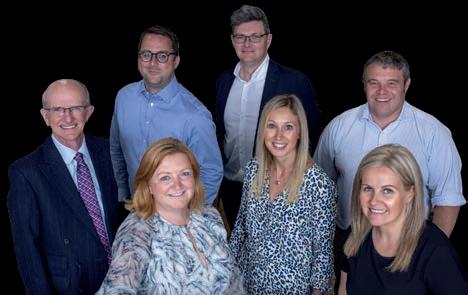
Later this month, GCRE will take the next step in its journey and offer partners in the private sector the chance to invest in the next, exciting phase of the project.

Details of the investment prospectus will be published in late November, but to discuss interest in GCRE and what it can do to support your business:
Contact: supplychain@gcre.wales
“Digitalisation of assets, predictive maintenance, creation of digital twins, artificial intelligence, machine learning – they all rely on data and the more data the better”.Robert Cook Policy Director

One year on from the UK-hosted COP26, where are we on progress to decarbonisation?
Ayear ago we saw commitments to move towards zero emissions road vehicles and aviation, but little attention given to rail specifically.
In part, this reflects that rail is a good news story. In the UK, whilst domestic transport has the largest share of UK greenhouse gas emissions of any sector, rail makes up just 1.4 percent of transport emissions.
Added to that, in the UK at least, a year ago it was unclear what would happen to the future demand for rail, with passenger levels having plummeted during the pandemic. However, since then passenger numbers have sprung back to 85-95 percent on the national network, if with somewhat different patterns of usage. While we certainly shouldn’t be complacent, especially about the need to continue to boost revenues, the evidence clearly shows that the demand to travel by rail continues to
be resilient over the long-term. In that context, a lack of specific commitments for rail a year ago was perhaps understandable, but a missed opportunity. And in the meantime, we’re another year closer
to 2050. This year, we need firm commitments from all governments to decarbonise across all forms of transport and at national, local, and international levels. An integrated multi-modal approach is essential.
Rail is a small part of the problem, but a big part of the solution. In 2019, rail made up 9.5 percent of all passenger kilometers (across all transport modes), but only 1.4 percent of the UK transport’s CO2 emissions.
Transport is intermodal by its nature
RIA has been recognised for industry-leading research into the best approaches needed to decarbonise rail.
and carbon is the common enemy across all modes of transport. Rail expansion can support other modes, as an alternative where road networks are heavily congested, or to remove high polluting HGVs from our streets, which will have a disproportionate impact on carbon emissions. A modal shift of 4 percent of passengers and 4 percent of freight to rail would save more carbon than the rail sector’s entire emissions.
To secure the huge opportunity that rail offers for green growth, two things are needed. Firstly, we need government commitment to major rail schemes, including HS2, EastWest Rail and Northern Powerhouse Rail. This will create further capacity on the rail network – not just to relieve pressure on rail, but as part of an integrated strategy that alleviates congestion across other modes and supports joined-up journeys.
Secondly, rail itself needs to decarbonise. Compared to our European counterparts, the UK railway sector is currently lagging well behind. For instance, around 60% of the UK rail network is still not electrified, and work progresses at half the rate needed to electrify fully by 2050.

RIA has been recognised for industry-leading research into the best approaches needed to decarbonise rail, with our work on electrification drawn on by the Transport Select Committee and others (and hot off the press, colleagues have just won a welldeserved Association Excellence Award for best lobbying campaign for RIA’s Rail Decarb 21 campaign).
Currently, electricity provides only 4 percent of UK rail freight’s energy requirement, compared with over 50 percent in continental Europe. Moreover in Europe, 80 percent of the Trans-European Transport Network is already electrified, and more than half the broader rail
network is electrified. This success is underpinned by ambitious EU electrification targets with a goal to electrify the whole core network by 2030, the extended core network by 2040, and the comprehensive network by 2050.
Historically, UK electrification has been relatively expensive, and the single biggest lesson is the need for a steady rolling programme. A steady volume of activity over the long term allows for the most cost-effective delivery of electrification and retains the specialist skills needed for engineering work. Battery and hydrogen solutions will also be needed on parts of the network and the success of these technologies will depend on a similar long-term investment approach too.
There are opportunities for quick wins. RIA’s research has suggested that electrifying just 10 percent of the network indicated in Network Rail’s Traction Decarbonisation
Network Strategy, equivalent to 500 miles, could mean that 70 percent of freight is able to run on electrified lines.
The investment needed isn’t just good for the environment. It also will boost growth and create jobs right across the country. Rail connects people, businesses and communities and improved connections can have a transformative effect on deprived areas. The UK railway industry already supports £43 billion in economic growth, 710,000 jobs, and £14 billion in tax revenue. For every £1 spent in rail, £2.50 of income is generated in the wider economy. Decarbonising the railway will create around 6,000 new job opportunities and £2.2bn of economic benefit in the UK.
As we look ahead to COP27, and political parties in the UK reach for policies that boost growth at the same time as delivering Net Zero, investment in rail is a good bet. ■
UK railway electrification has experienced sharp peaks and troughs, unlike Germany’s steady programme of investment.Gaynor Pates Operations Director
Gaynor Pates, our Operations Director, is also the current Chair of the Trade Association Forum (TAF), which exists to facilitate best practice sharing across all trade associations, working with the UK Government’s business department, BEIS, and other stakeholders. I guess you could say it is the Trade Association for Trade Associations!
Trade associations play a vital role in our economic and political society and provide valuable resources and opportunities for their members.
Here are 10 great reasons to be a member of a trade association:
Trade associations like RIA are the voice of your sector, representing the full range of businesses, voices, and interests. This sector perspective makes associations powerful and credible advocates, and much more so than any individual member business. Associations focus on maintaining relationships with critical stakeholders, so you don’t have to. Our staff at RIA are skilled professionals in public affairs, PR and policy, so are able to translate your business challenges to key “asks”
of decision makers such as DfT and BEIS ministers.
A trade association can say things to stakeholders and policymakers that you may not want to be seen saying as a business, or can’t because of market sensitivities or competition issues. For example, here at RIA we are not afraid of criticising the Government for their repeated failure to publish the Rail Network Enhancements Pipeline (RNEP). Trade associations are ideally placed to challenge government decisions, and key influencers, for the good of their members.
Trade associations offer a place for professional debate about key developments in your sector. We seek to identify and build consensus
around key challenges, seek alternative opinions, and share key information through our various RIA mailings, which you can use to help keep your business on the right track.
4. Industry and networking connections:
Here at RIA, we provide members with a range of different networking events which offer individuals opportunities to meet and learn from others in similar roles working across member companies, suppliers and other key players in rail. Our members’ events programme offers a perfect opportunity to build relationships with your counterparts, around shared interests. There were over 300 people at our recent networking reception at the British Embassy in Berlin during InnoTrans, and with similar annual
flagship events (which are open to non-members too) - around policy, innovation, public affairs, EDI and awards recognising supplier excellence - there is no shortage of opportunities to make valuable connections.
Like most trade associations, RIA provides members with a valuable source of examples, experience, and best practice, from across the rail industry. We often have answers to common questions from those in the sector or can help connect members who can help each other.
Trade associations are memberled, with boards, working groups and committees drawn from your industry. Getting involved through RIA can offer a route to give your staff skills and experiences they wouldn’t necessarily get otherwise, supporting their career aspirations, as well as your business objectives.

Unlike some other membershipbased companies, trade associations are generally “not for profit”, and are ultimately run to support your industry’s success, so you know your subscription is contributing to
the industry’s future. Having your business involved in the running of your association can be interesting and rewarding in many ways. You will raise your profile, meet new connections, and contribute to progressing a wider industry agenda, whether with a technical, legal, or commercial focus.
Trade associations provide members with access to useful information and resources, which saves each member time analysing the same information. During Covid, for example, RIA played a vital role in providing up-to-date guidance on
the changing rules and regulations within the sector. In highly regulated sectors, like rail, associations continue to provide a critical role in providing information to members in the post-pandemic world.
Trade associations, including RIA, employ people with a range of skills and expertise that members can call for advice across a wide range of issues including policy, public affairs, PR, innovation, exports and technical and all for significantly less than the price of one staff member. RIA colleagues are always more than happy to speak to any member as and when they require help or advice.

RIA sees itself as the greatest cheerleader for the rail supply sector, promoting its many successes and building its reputation. Trade associations also have a responsibility to promote the sector as an attractive career proposition and to ensure a supply of skills and labour for the sector in the future. That’s why RIA is proud to have launched the Equality, Diversity & Inclusion Charter, which is designed to bring the industry together to build a more balanced, fair and high performing railway. ■
Exporting can play a crucial role in enabling companies to find new customers and clients around world, helping to increase sales and boost business growth.
Whether a RIA member or not, UK companies can sign up to a
whole host of rail trade exhibitions around the world and join us at a UK pavilion. Taking part isn’t expensive and can lead to opportunities to sell products and services overseas.

There has never been a better time to explore the potential of exporting,
with the global market booming. UNIFE’s World Rail Market Study, the leading reference on the global rail supply market, provides a comprehensive overview of the global market and lays out an in-detail forecast of its projected future development. The latest
edition of this survey revealed that the global rail market will experience an average annual growth rate of 3.0 per cent through to 2027, reaching a global market volume of €211 billion between 2025 and 2027.
Among the key drivers of this positive market development is the growing foundation of mature markets, where railway undertakings and infrastructure managers consistently invest in the maintenance and extension of their infrastructure and rolling stock bases. In addition, the upgrading and modernisation of signalling systems is set to further drive the market in established rail regions along with new projects around the world.
This growth is also underpinned by a strong post-pandemic return to rail. In the UK, for example, we are now regularly seeing passenger numbers reach 90 – 95 percent of pre-pandemic levels, which is of course a vote of confidence in our industry both domestically and internationally.
Rail trade exhibitions are a brilliant way to get into exporting or to grow your existing exports operation. In 2023, RIA has a busy exports exhibition calendar, with spaces available at dedicated UK pavilions at the following exhibitions. So, alongside our partners Intec Export Intelligence, why not join us?
1. Eurasia Rail 2023, 8 – 10 March 2023, Istanbul, Turkey
This established rail and metro exhibition attracts around 8,000 visitors and is well worth attending if you are interested in exporting to the region. As it’s the key meeting place for the sector’s buyers and decision makers, attending Eurasia Rail is one the most effective ways to tap into Turkey’s lucrative railway sector.
2. Middle East Rail 2023, 15 – 16 May 2023, Abu Dhabi National Exhibition Centre, UAE
Middle East Rail 2023 will be once again hosted by Etihad Rail, bringing together public and private transport operators, government and the supply sector to plan and develop future projects in the region. With around 6000 visitors and 300 exhibitors, attending is a brilliant way to learn more about future opportunities and to meet key contacts.
3. Rail Solutions Asia 2023, 25 – 27 May 2023, Kuala Lumpur, Malaysia
Regarded by many as the best railway show in Asia, this annual event combines a wide-ranging exhibition with a packed conference programme. It is attended by the Asian Railway Operators Association, who often hold their annual congress at the event.
4. TRACKO 2023, 19 – 22 September 2023, Gdansk, Poland
TRAKO is the most prestigious rail gathering in Poland and one of the largest in Central and Eastern Europe, with around seven halls and an outside rollingstock area. Always well attended, with representation from Poland, Europe and around the world.
5. APTA EXPO 2023, 9 – 11 October, Orlando USA.
APTA EXPO plays a pivotal role in connecting industry leaders, influencers and decision makers with world-class exhibitors. Exhibitors can leverage the opportunity to launch new products, increase brand awareness or simply attract more qualified business prospects.
6. AusRAIL PLUS 2023, 13 – 16 November 2023, ICC Sydney, Australia
This is a well-attended exhibition and conference that provides a terrific opportunity to connect with rail professionals from across Australia and New Zealand. RIA is particularly looking for members who may want to exhibit at this event, so please get in touch if it is of interest.
We really hope that you will join RIA at some or even all these rail trade exhibitions and make the most of the immense opportunities they offer. To find out more, or if you have any questions at all, please contact me via neil.walker@riagb.org.uk. ■

Rail trade exhibitions are a brilliant way to get into exporting or to grow your existing exports operation. In 2023, RIA has a busy exports exhibition calendar, with spaces available at dedicated UK pavilions at the following exhibitions.
Kings Buildings, 16 Smith Square London SW1P 3HQ United Kingdom
T: +44 (0)207 201 0777
E: RIA@riagb.org.uk W: www.riagb.org.uk